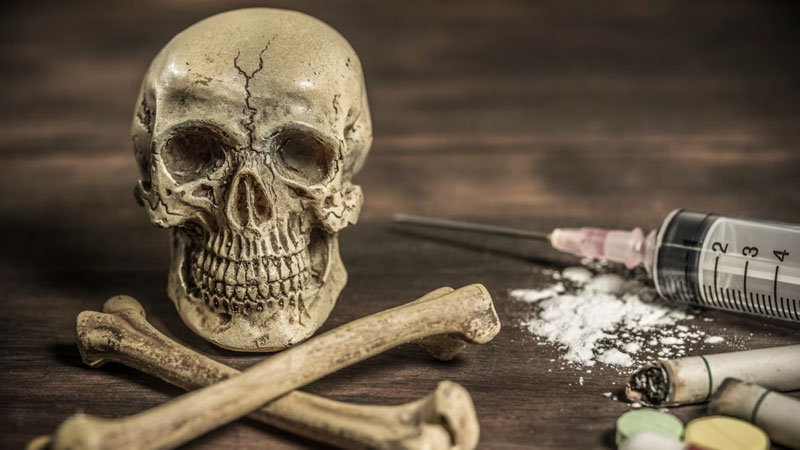Substances | 5 min read
What is Blue Meth? The Influence of Breaking Bad & Everything You Need to Know About Blue Meth
Medically Reviewed By

On May 15, 2023
Written By
On May 15, 2023

What you will learn
- Blue meth is a highly pure and potent form of meth that is depicted in the popular television show Breaking Bad.
- Blue meth is a fictional representation of methamphetamine but may have inspired blue forms of methamphetamine surfacing in some areas made in illicit meth labs.
- Meth labs can be identified by a strong or unusual chemical odor, high traffic to a remote areas, unusual or extreme security measures, the presence of hazardous materials, and heavy ventilation systems.
- Blue-tinted methamphetamine does not indicate purity but will have additives nearly 100% of the time and can be fatal.
“Breaking Bad,” the critically acclaimed television series, first premiered in 2008 and quickly became a cultural phenomenon.
“Breaking Bad” follows the story of a high school chemistry teacher, Walter White, who turns to a life of crime and starts producing methamphetamine, commonly known as “blue meth,” to secure his family’s financial future.
The show has been widely praised for its accurate representation of the drug world and the dangers associated with meth production and use. The series has also been credited for bringing the issue of meth and its destructive impact on society to the forefront.
However, despite its popularity and critical success, “Breaking Bad” has also faced criticism for potentially glamorizing the drug trade and promoting a dangerous lifestyle. Some argue that the show has contributed to a rise in the popularity of meth and drug culture in general.
Perhaps the most notable thing about the show is the production of a “pure” blue-tinted meth and everything that entails.
What, Exactly, is Blue Meth?
“Blue Meth” or “Blue Sky” is a reference to a highly pure and potent form of meth that is depicted in the popular television show “Breaking Bad.” In the show, the main character, Walter White, produces and sells a blue-tinted version of the drug, which becomes highly sought after due to its potency.
It is important to note that “Blue Meth” is a fictional representation of methamphetamine but is thought to have inspired “blue meth” that is surfacing in some areas.
Did “Breaking Bad” Influence Meth Use?
As humans, we often take cues from the media, even if it is subconsciously.
There is some evidence that the television show “Breaking Bad” may have influenced an increase in the popularity and glamorization of crystal meth.
However, the link between “Breaking Bad” and increased meth use is not clear-cut and is likely influenced by various factors, such as changes in drug supply, cultural attitudes towards drug use, and access to treatment and support.
Breaking Bad: a Cautionary Tale of Meth Production and Use
Despite its potential influence on attitudes towards meth use, “Breaking Bad” also serves as a warning about the dangers and consequences of substance abuse.
The show highlights the negative impact that meth use can have on individuals, families, and communities and provides a powerful message about the importance of avoiding drugs and seeking help if needed.
Did Breaking Bad Teach People How to Identify Methamphetamine Labs?
Another unintentional benefit of the “Breaking Bad” depiction of crystal methamphetamine production, which may make it easier for people to identify meth labs.
Strong or Unusual Chemical Odor
Meth production often involves the use of strong and unusual chemicals, which can produce a distinctive and often overpowering odor.
High Traffic to a Remote Areas
Meth labs can be found anywhere but are often located in remote or secluded areas.[1] If you notice a high level of traffic, including frequent visitors, or coming and going at all hours of the day and night to a secluded area, it could be a sign a meth lab is in the area.
Unusual or Extreme Security Measures
Meth producers may take steps to protect their operation, including installing extensive security camera equipment, alarms, locked gates, guard dogs, and even armed guards.
The Presence of Hazardous Materials
Meth is made with a number of hazardous materials. These materials may be visible outside the lab, including empty containers of household or industrial chemicals,
Ventilation Systems
Meth production often requires the use of a large amount of ventilation to remove fumes, and there may be an unusual number of ducts, fans, or hoses connected to the building.
Not all of these signs may be present at every meth lab, and many of these signs can also be present in other types of properties.
If you suspect that a property is being used as a meth lab, it’s important to contact law enforcement immediately and not to enter the property. Meth labs can be extremely dangerous and pose a serious risk to both public health and safety.
What Are The Different Forms of Meth?
Different forms of methamphetamine exist, each with varying appearances and levels of potency. The most common forms are powder, base, and crystal. There is also “pink meth” which is a form of methamphetamine with a unique rosy-pink color.
The powder is a white or off-white powder and is the least potent. It can be taken in different ways, including snorting, injecting, or swallowing. Base is a damp or oily substance that is stronger and purer than powder and is usually injected. Crystal, also known as “ice,” is the most potent form and is usually smoked or injected.
What is “Pure” Meth?
The term “pure” is often used to describe the drug when it has been processed and refined to a high degree, resulting in a product that is more potent and more dangerous than other forms of the drug. However, even “pure” methamphetamine can contain impurities and contaminants, and using the drug can have serious health consequences.
What are the Side Effects of Meth Use?
Meth use results in both physical and psychological side effects.[2] Meth’s physical side effects include heart damage and irregular heart rate, memory loss, trouble regulating body temperature, “meth mouth,” damage to the central nervous system, weight loss, severe mental health problems, and even death.
Psychological side effects of meth use are memory loss, psychosis, violent behavior, depression, and sudden mood swings.
How Do You Stop Using Meth?
Real life is not like television. Recovering from meth addiction can be a long, difficult road. Addiction treatment for meth typically includes detox, inpatient care, intensive outpatient programs, outpatient programs, and aftercare services.
Each of these levels of care focuses on helping patients prevent relapse through multitudinous therapies, including talk therapies, cognitive behavioral therapy (CBT), dialectical behavioral therapy (DBT), and supplemental holistic therapies and trauma therapies like EMDR.
Is Detoxing Painful?
Traditional detox methods have a reputation for being uncomfortable and even dangerous, which is why many people addicted to methamphetamine use avoid detox.
But modern-day detox methods make medically supervised detox comfortable and safe and help prepare you to enter a drug abuse treatment program ready to focus fully on recovery.
Inpatient and Outpatient Meth Addiction Programs: Start Here
While “Blue Meth” has been glamorized by the “Breaking Bad” TV show, methamphetamine is a highly addictive and dangerous stimulant drug that can cause a wide range of physical and psychological side effects, as well as has the potential to be fatal.[3]
At Ascendant NY, we offer both inpatient and outpatient levels of care at our facility.
If you are new in recovery, at high risk for relapse, or have a co-occurring mental or physical health condition that may make recovery more difficult, it may be recommended that you begin your recovery journey in an inpatient facility.
If you are unable to attend inpatient care or are self-assured in your recovery post-detox, an intensive outpatient program (IOP) may be recommended for you.
The best option for you will be determined together with your care team.
Frequently Asked Questions About Blue Meth
In “Breaking Bad,” Walter White adds a dye to his batches of methamphetamine to give it a blue color. This blue tint serves as his “signature” so that drug dealers and users would know where it came from. Although Walter White claims that his meth is “pure,” it is crucial that the public realize that blue-tinted methamphetamine does not indicate purity and can be fatal. Blue-colored meth, like other meth, will have additives nearly 100% of the time.[4]
Breaking Bad” has been widely praised for its accurate portrayal of science and the drug trade. However, the show is a work of fiction and does take creative liberties for the sake of storytelling.
Some details and events have been altered for dramatic effect, and the show is not a documentary. Overall, “Breaking Bad” is a well-made series, but viewers should not rely on it for accurate information about the science of chemistry or the drug trade.
We work with most major insurance companies. During your admissions screening, we will confirm your coverage with your provider. Most major insurance carriers cover at least some substance use treatment options, including stays at a residential treatment center
Call Today. Start Treatment Tomorrow.
If you or a loved one is struggling with methamphetamine addiction, it is never too late to commit to recovery.With the right treatment and support, it is possible to overcome substance addiction and build a healthier, drug-free life. Call and speak with a member of our admissions team today and let us know how we can help you overcome a methamphetamine addiction.
Ascendant New York Editorial Guidelines
Here at Ascendant New York, we understand the importance of having access to accurate medical information you can trust, especially when you or a loved one is suffering from addiction. Find out more on our policy.
[1] Department of Justice. Methamphetamine laboratory identification and Hazards Fast Facts. (n.d.) Retrieved from https://www.justice.gov/archive/ndic/pubs7/7341/index.htm
[2]Edinoff, A. N., Kaufman, S. E., Green, K. M., Provenzano, D. A., Lawson, J., Cornett, E. M., Murnane, K. S., Kaye, A. M., & Kaye, A. D. (2022, September 15). Methamphetamine use: A narrative review of adverse effects and related toxicities. Health psychology research. https://www.ncbi.nlm.nih.gov/pmc/articles/PMC9476235/
[3] NIDA. (2021, September 22) Methamphetamine-involved overdose deaths nearly tripled between 2015 to 2019, NIH study finds. Retrieved from https://archives.nida.nih.gov/news-events/methamphetamine-involved-overdose-deaths-nearly-tripled-between-2015-to-2019-nih-study-finds
[4] Forum, A. P. (2022, October 17). Understanding methamphetamine. APF. Retrieved from https://www.addictionpolicy.org/post/research-you-can-use-understanding-methamphetamine




